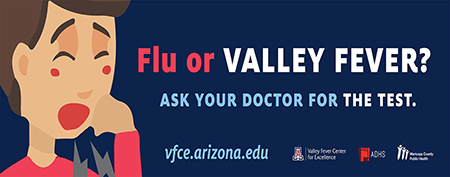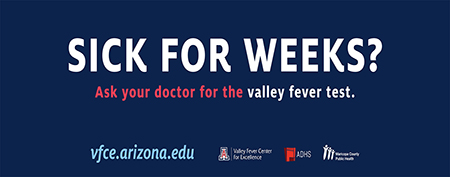Public awareness of the respiratory risks of Valley fever infection and beyond will get two big boosts in March with a billboard campaign in the Phoenix area and a Tucson Lifestyle magazine article for its monthly “In Health” feature.
Knowledge is Power
 The billboard campaign will begin March 4 with a billboard on Interstate 10 between Guadalupe and Elliot Roads and another at the Arizona 101 and Arizona 202 Loop interchange.
The billboard campaign will begin March 4 with a billboard on Interstate 10 between Guadalupe and Elliot Roads and another at the Arizona 101 and Arizona 202 Loop interchange.
You may see one of these images soon as a billboard on I-10 or the AZ101/202 Loop interchange in Phoenix. (Click to enlarge.)
It’s sponsored by the University of Arizona Valley Fever Center for Excellence, Arizona Department of Health Services (ADHS), and Maricopa County Department of Public Health with financial support from IMMY, a company based in Norman, Okla., that manufactures diagnostic tests for detection of a range of fungal diseases including Valley fever.
diseases including Valley fever.
Valley fever, also known as coccidioidomycosis or cocci, is a disease that results from inhaling fungal spores found in the soils of the U.S. Southwest. Common symptoms are respiratory distress similar to those caused by flu or bacterial pneumonia. Because the illnesses are so similar, many cases of Valley fever are incorrectly diagnosed and treated with antibiotics, which are of no help. For some, the unrecognized illness can move past the lungs and become life threatening.
 Raising
Raising  awareness of Valley fever and promoting proper testing for faster recognition is part of the mission of the Valley Fever Center for Excellence, created by the Arizona Board of Regents in 1996 at the University of Arizona in Tucson and led since then by John N. Galgiani, MD, as founding director.
awareness of Valley fever and promoting proper testing for faster recognition is part of the mission of the Valley Fever Center for Excellence, created by the Arizona Board of Regents in 1996 at the University of Arizona in Tucson and led since then by John N. Galgiani, MD, as founding director.
“Public awareness really promotes public health because people who know about Valley fever before they fall ill from it, whether it’s mild or severe, may get the diagnosis sooner,” he said. “That’s because they ask their doctor, ‘Do you think I have Valley fever?,’ and thereby get tested earlier. That speeds up the process. At least, many times that’s the case, we’ve found.”
 Dr. Galgiani noted that the billboard campaign was made possible by an unrestricted education grant from IMMY to the UA Foundation.
Dr. Galgiani noted that the billboard campaign was made possible by an unrestricted education grant from IMMY to the UA Foundation.
Messaging was coordinated through the VFCE, Kenneth Komatsu, MPH, state epidemiologist with ADHS, and Rebecca Sunenshine, MD, medical director for disease control at Maricopa County Department of Public Health. UA Brand Resources and UA Health Sciences Biocommunications also contributed.
Sharing Awareness
 The Tucson Lifestyle article — look for it in the March issue — focuses largely on a recently released UA/Banner Health Valley Fever Clinical Practice Toolbox and tutorials available to help clinicians better identify Valley fever in their patients more quickly, whether those patients are people or animals.
The Tucson Lifestyle article — look for it in the March issue — focuses largely on a recently released UA/Banner Health Valley Fever Clinical Practice Toolbox and tutorials available to help clinicians better identify Valley fever in their patients more quickly, whether those patients are people or animals.
Another aspect of the center’s work involves research to develop a vaccine to prevent Valley fever. In the magazine article, you’ll find an update on that work both for a vaccine for dogs and efforts to get Nikkomycin Z, an antifungal/antibiotic for humans, back into clinical trials for humans. Other research focuses on identifying possible genetic reasons why Valley fever affects some differently — with African Americans more likely to suffer from disseminated cocci (the more severe form that spreads beyond the lungs), for instance — and to develop precision medicine therapies to address that. 
The toolbox, though, was created through a protocol development process at Banner Health and is targeted at primary care physicians who are the first line of defense from a clinical perspective. Dr. Galgiani and Fariba Donovan, MD, PhD, are traveling to 39 Banner Health primary care facilities to offer physician training seminars on the new clinical practice. It is available publicly as well to all physicians at the link above.
About UA Valley Fever Center for Excellence
In 1996, the Arizona Board of Regents established the Valley Fever Center for Excellence at the University of Arizona to address problems created by a fungus, Coccidioides, that’s endemic to soils of the U.S. Southwest and the cause of Valley fever. Some cases are mild; some so severe that the infection spreads past the lungs. Valley fever also affects animals, including pets and livestock. The center, which is affiliated with the UA Colleges of Medicine – Tucson and Phoenix through the UA Department of Medicine and Division of Infectious Diseases, works to spread public awareness and education about Valley fever, promote high-quality care for the disease and pursue research to improve treatment therapies and develop a vaccine. Learn more: vfce.arizona.edu
About the UA Department of Medicine
The University of Arizona Department of Medicine is one of six original departments and the largest at the UA College of Medicine – Tucson, with 14 divisions covering medical subspecialties from cardiology to infectious diseases to rheumatology. The faculty includes more than 250 physicians who help train more than 70 fellows in 18 fellowship programs, 130 residents in internal medicine and dermatology, and 450 medical students engaged in clerkships, sub-internships and research opportunities. Affiliated with UA institutes and centers of excellence and collaborative cohorts across the nation and world, the department’s investigators are leading research into development of personalized precision medicine therapies for both basic and complex diseases to improve the lives of people in Arizona and abroad. Learn more: deptmedicine.arizona.edu
NOTE TO MEDIA: For educational pamphlets, brochures, images and graphics related to Valley fever—as well as contact information for University of Arizona faculty knowledgeable about the illness—visit the following webpage: UA Expertise on Valley Fever (Coccidioidomycosis)
ALSO SEE:
“Valley Fever Awareness Week, More Like a Month in 2018, Promoted by UA Center” | Posted Nov. 16, 2018
“New UA/Banner Health Valley Fever Clinical Guidelines to Help Avoid Delays in Diagnosis” | Posted Nov. 14, 2018
“New UA/Banner Health Valley Fever Clinical Guidance Designed to Avert Diagnoses Delays” | Posted Oct. 8, 2018
“UA Valley Fever Center, ADHS, Tucson’s Pueblo High Host Youth Awareness Poster Contest” | Posted Oct. 5, 2018
“Healthy Dose Blog Takes Aim at Valley Fever for Fungal Disease Awareness Week” | Posted Oct. 4, 2018

